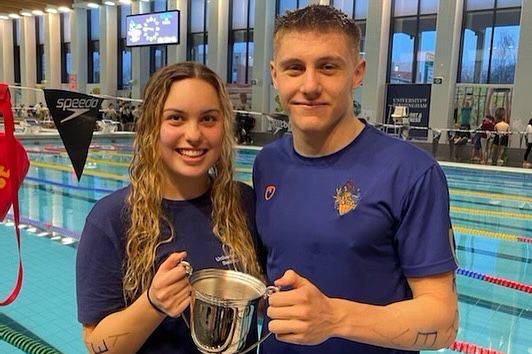The University of Surrey clinched the Crystal Brown Cup at the British University Swimming League’s (BUSL) first National Final on March 19th.
The BUSL is a newfound, student-run league inspired by the NCAA dual meet format. Previously, the league was known as the National University Development League (NUDL) and was founded by Jack Corston when he was a student at the University of Sheffield in 2019. Last year, Ewan Taylor, a swimmer for the University of Surrey, collaborated with Corston and developed the BUSL.
The BUSL’s first season was structured and separated into three phases. During the first phase which spanned from October to December, thirteen conferences of four teams each competed in three localized, dual matches. In the second phase, the four teams congregated at one venue to compete in an ‘arena-league style’ Conference Championship Gala. Each team was allowed to enter one non-point scoring team in order to invite more swimmers to race. For the third phase, the 13 winning teams from their Conference Championship meet convened at the University of Birmingham for the National Final. The BUSL included three wildcard teams–those with the next best scores–in order to accommodate 16 total teams. Here, the team that ends with the most points is the winner of the BUSL.
The meet schedule in the BUSL is significantly different from that in the British Universities and Colleges Sport (BUCS). Compared to the vast number of competitions in the BUSL, BUCS only offers three championship meets that get more selective consecutively. The season opens with the Short Course Championships which is open to all BUCS swimmers. The Long Course Championships follow and limit teams’ individual entries to two swimmers per event and three entries for each competitor. For the season-ending Team Championships, only 18 swimmers per team participate. Furthermore, the teams are separated into three divisions at the Team Champs: Championship, Trophy, and Shield.
The Championship division features the highest level of competition with Trophy being a tier below and Shield at the lowest level. BUCS determines these divisions by evaluating the previous year’s results and using the promotion and relegation system. 20 teams are assigned to each division.
All three meets transpired at the same facility in Sheffield during the months of November, February, and April. Since BUCS athletes receive very little funding, they have to cover some, if not all, of the costs for transport, hotel, food, and meet entries. Although BUCS is partnered with Speedo and has used the support to relieve financial strain, swimmers still had to pay £16.75 (about $21) per individual entry.
The financial responsibilities that accompany BUCS are unlike that of the BUSL. The league’s mission is to promote inclusivity, affordability, and more competitive opportunities that also encourage fun, friendly competition. Taylor stressed that little to no profit would be made from organizing meets. In fact, most of the costs were exclusive to the team entry fees for the National Final. With the reduction in expenses, more swimmers were interested to compete. Taylor noted that there were BUCS swimmers who competed in both BUCS and the BUSL. Schools still encouraged swimmers who were not selected for BUCS to compete in the BUSL.
Under the NUDL, only 15 teams–approximately 175 swimmers–participated in 2019. The following year, the NUDL went virtual and had 19 teams–approximately 220 swimmers–compete. The BUSL saw considerable growth as 52 teams–about 1300 swimmers–raced in its first season.
BUCS is aware of BUSL’s existence, and there is no rivalry between the two. The meet schedule for the BUSL was created to prevent any schedule conflicts. Taylor’s hope for the BUSL is to one day merge with BUCS swimming so that it replicates the NCAA’s structure.
Currently, Taylor is communicating with other swim brands to gain more supporters that will reduce pool hire and meet entry expenses. Though the National Final did receive merchandise from companies like Red Bull, Arena, and Mailsports, Taylor hopes to increase the BUSL’s exposure and remove any financial burdens.
Check out the main website run by Taylor and Corston to find the BUSL’s results.

Are there any final standing outside Surrey winning? Did many Russell group Unis take part?
About 3/4 of the Russell group unis took part, and 52 total, although this was a big increase on the previous year so who knows how many next year!
Final standings were:
1: Surrey
2: Nottingham
3: Sheffield Hallam
4: Birmingham
5: Lancaster
6: Swansea
7: Exeter
8: Liverpool
9: Kings College London
10: York
11: Southampton
12: Cardiff Met
13: Dundee
14: St Andrew’s
15: Leeds
Instagram link’s here if you want more info too!
https://instagram.com/buswimleague?igshid=YmMyMTA2M2Y=
You love too see it!